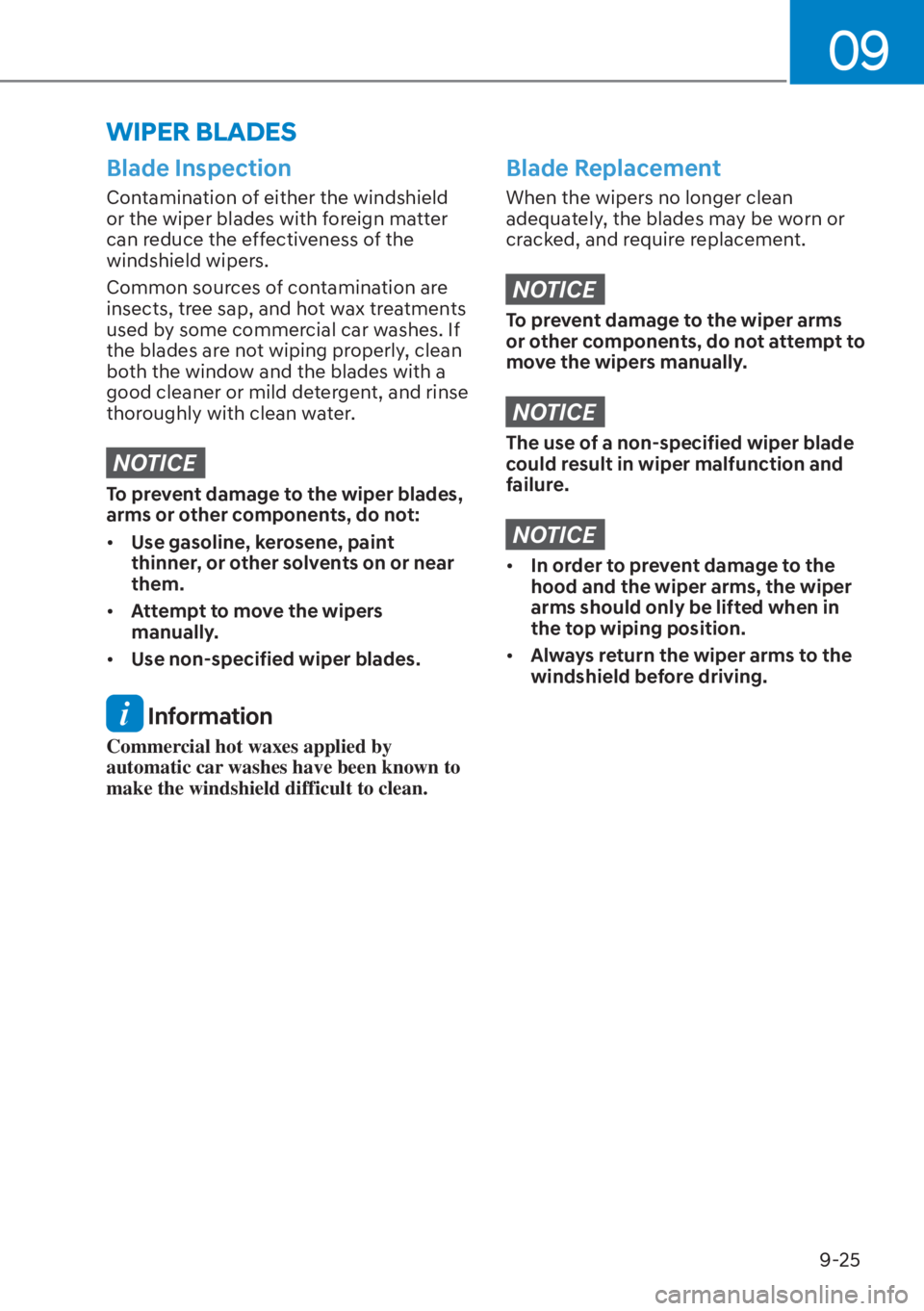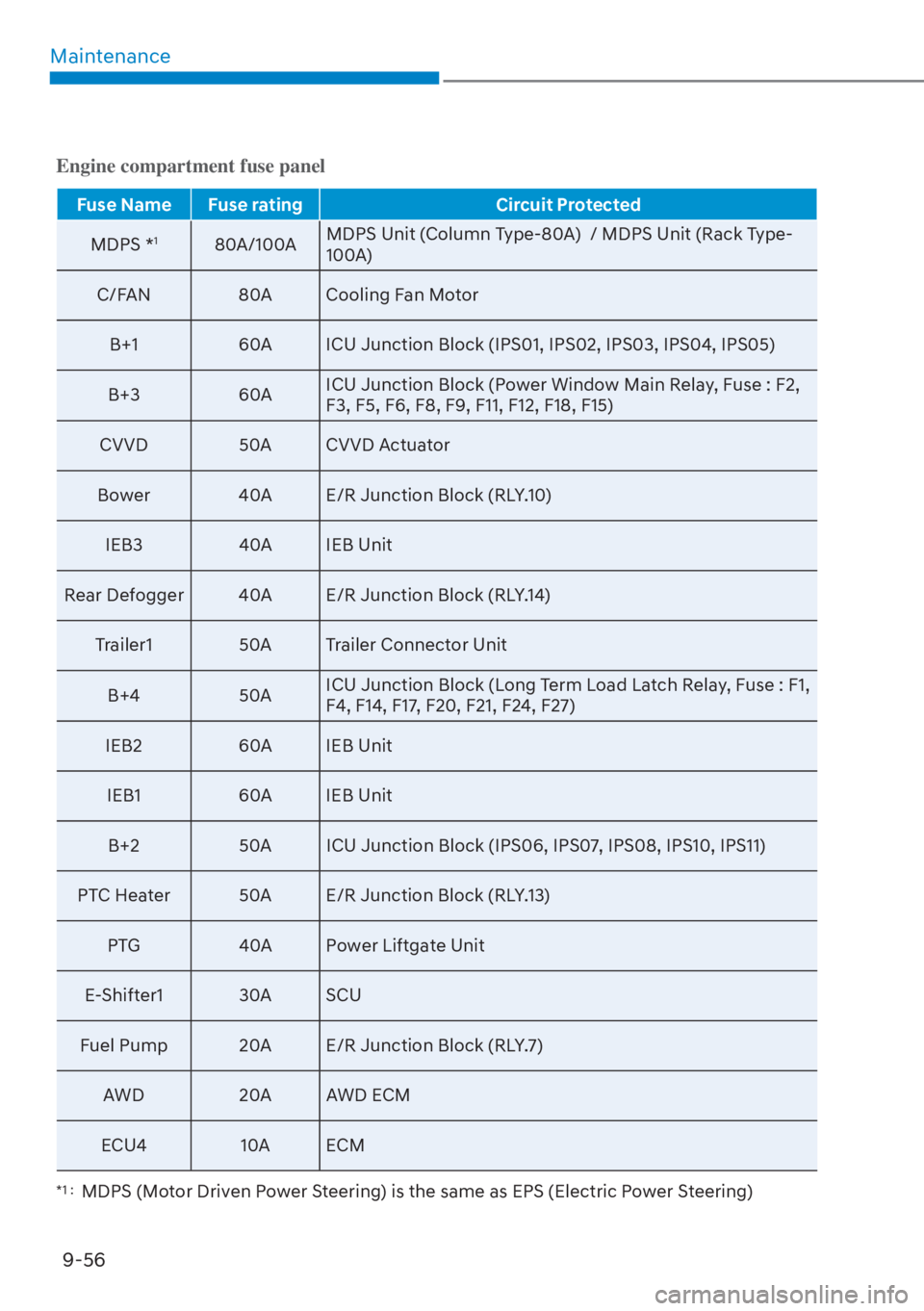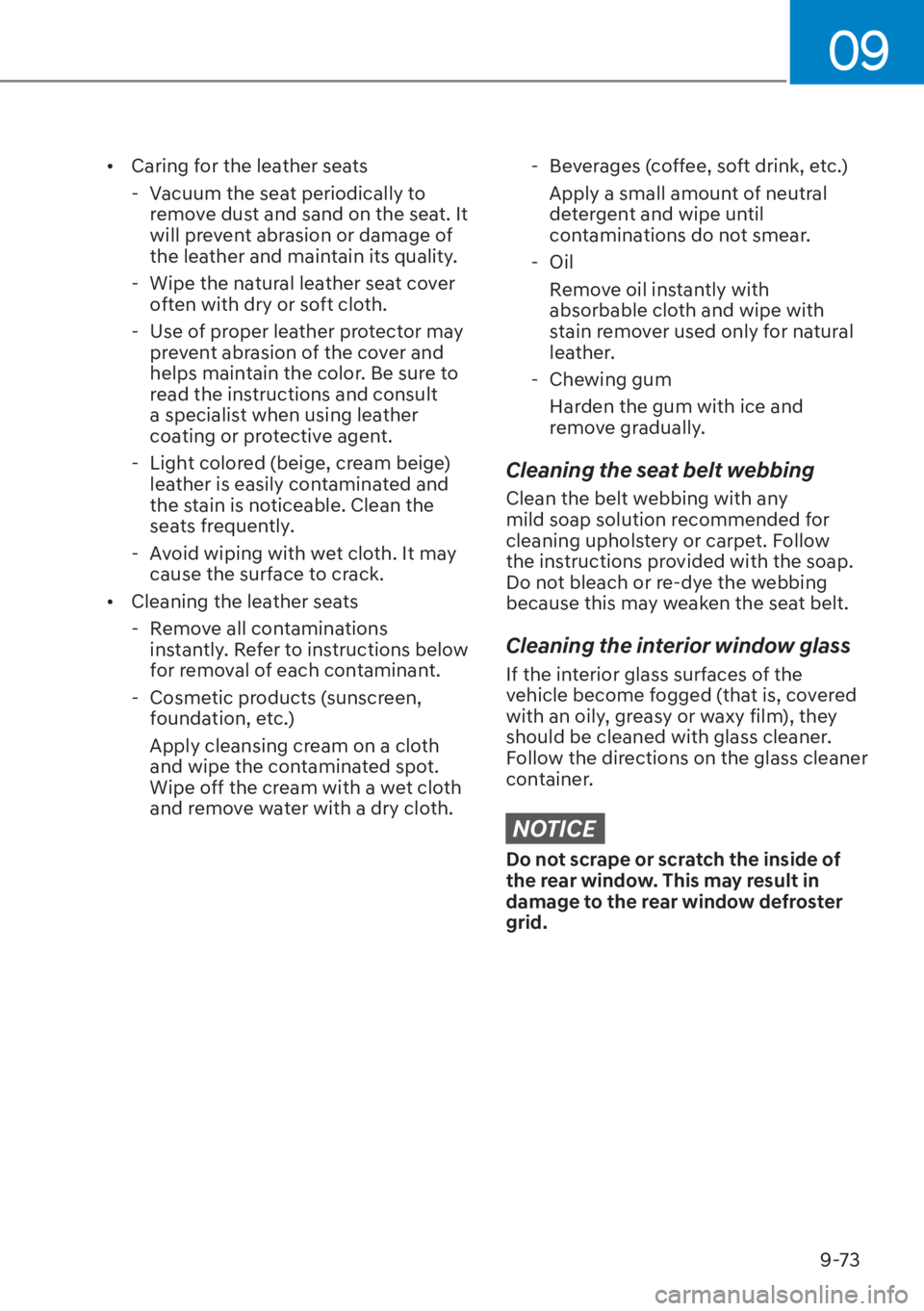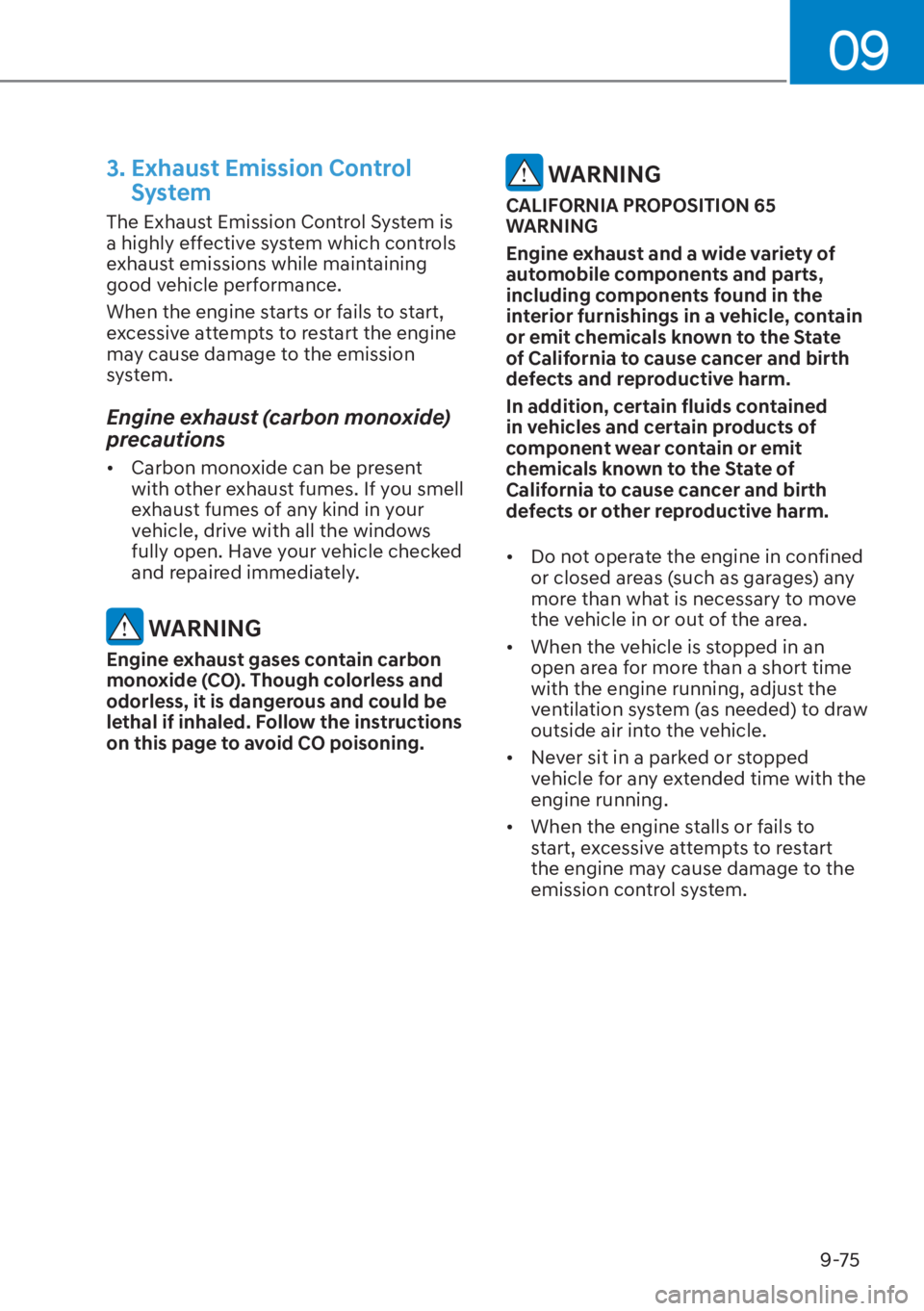2023 HYUNDAI TUCSON HYBRID window
[x] Cancel search: windowPage 647 of 699

09
9-25
Blade Inspection
Contamination of either the windshield
or the wiper blades with foreign matter
can reduce the effectiveness of the
windshield wipers.
Common sources of contamination are
insects, tree sap, and hot wax treatments
used by some commercial car washes. If
the blades are not wiping properly, clean
both the window and the blades with a
good cleaner or mild detergent, and rinse
thoroughly with clean water.
NOTICE
To prevent damage to the wiper blades,
arms or other components, do not:
• Use gasoline, kerosene, paint
thinner, or other solvents on or near
them.
• Attempt to move the wipers
manually.
• Use non-specified wiper blades.
Information
Commercial hot waxes applied by
automatic car washes have been known to
make the windshield difficult to clean.
Blade Replacement
When the wipers no longer clean
adequately, the blades may be worn or
cracked, and require replacement.
NOTICE
To prevent damage to the wiper arms
or other components, do not attempt to
move the wipers manually.
NOTICE
The use of a non-specified wiper blade
could result in wiper malfunction and
failure.
NOTICE
• In order to prevent damage to the
hood and the wiper arms, the wiper
arms should only be lifted when in
the top wiping position.
• Always return the wiper arms to the
windshield before driving.
WIPER BLADES
Page 649 of 699

09
9-27
Type B
OTM090039OTM090039
1. Raise the wiper arm.
OTM090040OTM090040
2. Lift up the wiper blade clip. Then pull down the blade assembly and remove
it.
OTM090041OTM090041
3. Install the new blade assembly in the reverse order of removal.
4. Return the wiper arm on the windshield.
Rear window wiper blade
replacement
Move the rear wiper to the bottom
middle part, and lift up the wiper arm.
Pull the wiper blade to remove it.
ONX4090039ONX4090039
1. Within 20 seconds after the vehicle ignition is OFF, pull down the wiper
lever to MIST position for over 2
seconds until the wiper moves down
to the bottom middle part.
ONX4090040ONX4090040
2. Raise the wiper arm.
Page 655 of 699

09
9-33
NOTICE
AGM battery (if equipped)
• Absorbent Glass Mat (AGM) batteries
are maintenance-free and have
the AGM battery serviced by an
authorized HYUNDAI dealer. For
charging your AGM battery, use only
fully automatic battery chargers that
are specially developed for AGM
batteries.
• When replacing the AGM battery,
use parts for replacement from an
authorized HYUNDAI dealer.
• Do not open or remove the cap on
top of the battery. This may cause
leaks of internal electrolyte that
could result in severe injury.
By jump starting
After a jump start from a good battery,
drive the vehicle for 20-30 minutes
before it is shutoff. The vehicle may
not restart if you shut it off before the
battery had a chance to adequately
recharge. See “Jump Starting” in chapter
9 for more information on jump starting
procedures.
Information
An inappropriately disposed
battery can be harmful to the
environment and human health.
Dispose of the battery according
to your local law(s) or regulation.
Reset Items
The following items may need to be reset
after the battery has been discharged or
the battery terminal (For plug-in hybrid
vehicle) or battery connector (For hybrid
vehicle) has been disconnected.
• Auto up/down window (see chapter 5)
• Sunroof (see chapter 5)
• Trip computer (see chapter 5)
• Climate control system (see chapter 5)
• Driver position memory system (see
chapter 5)
• Clock (see chapter 5)
• Infotainment system (see infotainment system manual)
Page 673 of 699

09
9-51
Instrument panel fuse panel
Fuse Name Fuse ratingCircuit Protected
DR Lock 20A Dead L
ock Relay, Data Link Connector, Door Unlock/Lock
Relay
P/WDW RH 25A Power Window Main Switch, Passenger Power Window
Switch (LHD)
P/WDW LH 25A Power Window Main Switch, Passenger Power Window
Switch (RHD)
Seat Warmer (RR) 20A Rear Seat Warmer Control Module
Seat Warmer (DR/PS) 20AFront Seat Warmer Control Module, Front Air Ventilation
Seat Control Module
P/Seat(PS) 30A Passenger Power Seat Switch, Passenger Seat Relay Unit
ECS 15A ECS Unit
Safety
Window RH 25ADriver(LHD)/Passenger(RHD) Safety Power Window Module,
Rear Safety Power Window Module RH
Sunroof1 20A Sunroof Control Unit (Blind)
P/Seat(DR) 30A Driver Power Seat Switch, Driver IMS Control Module A/BAG2 10A SRS Control ModuleAMP 25A AMP
Module17 10A "Driver/Passenger Smart Key Outside Handle, Crash Pad
Switch, Hazard Switch, UIP Sensor
UIP Siren, Data Link Connector, Rain Sensor"
Sunroof1 20A Sunroof Control Unit (Glass)
IBU2 10A IBU, Ignition Switch
Safety
Window LH 25ADriver(RHD)/Passenger(LHD) Safety Power Window Module,
Rear Safety Power Window Module LH
10A 10AOutside Mirror Folding/Unfolding Relay, ROA Sensor, Driver
IMS Control Module, Power Liftgate Unit, Driver/Passenger
Door Mood Lamp, A/C Control Module, Console Mood
Lamp, Instrument Cluster, Mood Lamp Unit, A/C Control
Switch, Crash Pad Mood Lamp
Brake Switch 10A IBU, Stop Lamp Switch
Page 678 of 699

Maintenance9-56
Engine compartment fuse panel
Fuse Name Fuse rating Circuit Protected
MDPS *
180A/100A MDPS Unit (Column Type-80A) / MDPS Unit (Rack Type-
100A)
C/FAN 80A Cooling Fan Motor
B+1 60A ICU Junction Block (IPS01, IPS02, IPS03, IPS04, IPS05)
B+3 60A ICU Junction Block (Power Window Main Relay, Fuse : F2,
F3, F5, F6, F8, F9, F11, F12, F18, F15)
CVVD 50A CVVD Actuator
Bower 40A E/R Junction Block (RLY.10) IEB3 40A IEB Unit
Rear Defogger 40A E/R Junction Block (RLY.14) Trailer1 50A Trailer Connector Unit
B+4 50A ICU Junction Block (Long Term Load Latch Relay, Fuse : F1,
F4, F14, F17, F20, F21, F24, F27)
IEB2 60A IEB Unit
IEB1 60A IEB UnitB+2 50A ICU Junction Block (IPS06, IPS07, IPS08, IPS10, IPS11)
PTC Heater 50A E/R Junction Block (RLY.13) PTG 40A Power Liftgate Unit
E-Shifter1 30A SCU
Fuel Pump 20A E/R Junction Block (RLY.7) AWD 20A AWD ECM
ECU4 10A ECM
*1 : MDPS (Motor Driven Power Steering) is the same as EPS (Electric Power Steering)
Page 689 of 699

09
9-67
APPEARANCE CARE
Exterior CareNOTICE
If you park your vehicle near a stainless
steel sign or glass facade building, the
vehicle’s exterior plastic parts such
as a bumper, spoiler, garnish, lamp
or outside rearview mirror might be
damaged due to sunlight reflected from
the sign or building. To prevent damage
of the exterior plastic parts, you should
avoid parking in areas where light may
be reflected or use a car cover. (The
exterior plastic parts applied to your
vehicle may vary.)
Exterior general caution
It is very important to follow the label
directions when using any chemical
cleaner or polish. Read all warning and
caution statements that appear on the
label.
Finish maintenance
Washing
To help protect your vehicle’s finish from
rus
t and deterioration, wash it thoroughly
and frequently at least once a month
with lukewarm or cold water.
If you use your vehicle for off-road
driving, you should wash it after each
off-road trip. Pay special attention to the
removal of any accumulation of salt, dirt,
mud, and other foreign materials. Make
sure the drain holes in the lower edges
of the doors and rocker panels are kept
clear and clean.
Insects, tar, tree sap, bird droppings,
industrial pollution and similar deposits
can damage your vehicle’s finish if not
removed immediately.
Even prompt washing with plain water
may not completely remove all these
deposits. A mild soap, safe for use on
painted surfaces, should be used.
After washing, rinse the vehicle
thoroughly with lukewarm or cold water.
Do not allow soap to dry on the finish.
High-pressure washing
• When using high-pressure washers, mak
e sure to maintain sufficient
distance from the vehicle.
Insufficient clearance or excessive
pressure can lead to component
damage or water penetration.
• Do not spray the camera, sensors or its surrounding area directly with a
high pressure washer. Shock applied
from high pressure water may cause
the device to not operate normally.
• Do not bring the nozzle tip close to boots (rubber or plastic covers) or
connectors as they may be damaged
if they come into contact with high
pressure water.
WARNING
After washing the vehicle, test the
brakes while driving slowly to see
if they have been affected by water
before getting on the road. If braking
performance is impaired, dry the
brakes by applying them lightly while
maintaining a slow forward speed.
NOTICE
• Do not use strong soap, chemical
detergents or hot water, and do not
wash the vehicle in direct sunlight
or when the body of the vehicle is
warm.
• Be careful when washing the side
windows of your vehicle.
• Especially, with high-pressure water,
water may leak through the windows
and wet the interior.
• To prevent damage to the plastic
parts, do not clean with chemical
solvents or strong detergents.
• To prevent damage to the charging
door, make sure to close and lock the
vehicle doors when washing (high-
pressure washing, automatic car
washing, etc.) the vehicle.
Page 695 of 699

09
9-73
• Caring for the leather seats - Vacuum the seat periodically to remove dust and sand on the seat. It
will prevent abrasion or damage of
the leather and maintain its quality.
- Wipe the natural leather seat cover often with dry or soft cloth.
- Use of proper leather protector may prevent abrasion of the cover and
helps maintain the color. Be sure to
read the instructions and consult
a specialist when using leather
coating or protective agent.
- Light colored (beige, cream beige)
leather is easily contaminated and
the stain is noticeable. Clean the
seats frequently.
- Avoid wiping with wet cloth. It may cause the surface to crack.
• Cleaning the leather seats
- Remove all contaminations
instantly. Refer to instructions below
for removal of each contaminant.
- Cosmetic products (sunscreen, foundation, etc.)
Apply cleansing cream on a cloth
and wipe the contaminated spot.
Wipe off the cream with a wet cloth
and remove water with a dry cloth. - Beverages (coffee, soft drink, etc.)
Apply a small amount of neutral
detergent and wipe until
contaminations do not smear.
- Oil
Remove oil instantly with
absorbable cloth and wipe with
stain remover used only for natural
leather.
- Chewing gum Harden the gum with ice and
remove gradually.
Cleaning the seat belt webbing
Clean the belt webbing with any
mild soap solution recommended for
cleaning upholstery or carpet. Follow
the instructions provided with the soap.
Do not bleach or re-dye the webbing
because this may weaken the seat belt.
Cleaning the interior window glass
If the interior glass surfaces of the
vehicle become fogged (that is, covered
with an oily, greasy or waxy film), they
should be cleaned with glass cleaner.
Follow the directions on the glass cleaner
container.
NOTICE
Do not scrape or scratch the inside of
the rear window. This may result in
damage to the rear window defroster
grid.
Page 697 of 699

09
9-75
3. Exhaust Emission Control System
The Exhaust Emission Control System is
a highly effective system which controls
exhaust emissions while maintaining
good vehicle performance.
When the engine starts or fails to start,
excessive attempts to restart the engine
may cause damage to the emission
system.
Engine exhaust (carbon monoxide)
precautions
• Carbon monoxide can be present
with other exhaust fumes. If you smell
exhaust fumes of any kind in your
vehicle, drive with all the windows
fully open. Have your vehicle checked
and repaired immediately.
WARNING
Engine exhaust gases contain carbon
monoxide (CO). Though colorless and
odorless, it is dangerous and could be
lethal if inhaled. Follow the instructions
on this page to avoid CO poisoning.
WARNING
CALIFORNIA PROPOSITION 65
WARNING
Engine exhaust and a wide variety of
automobile components and parts,
including components found in the
interior furnishings in a vehicle, contain
or emit chemicals known to the State
of California to cause cancer and birth
defects and reproductive harm.
In addition, certain fluids contained
in vehicles and certain products of
component wear contain or emit
chemicals known to the State of
California to cause cancer and birth
defects or other reproductive harm.
• Do not operate the engine in confined or closed areas (such as garages) any
more than what is necessary to move
the vehicle in or out of the area.
• When the vehicle is stopped in an open area for more than a short time
with the engine running, adjust the
ventilation system (as needed) to draw
outside air into the vehicle.
• Never sit in a parked or stopped vehicle for any extended time with the
engine running.
• When the engine stalls or fails to start, excessive attempts to restart
the engine may cause damage to the
emission control system.